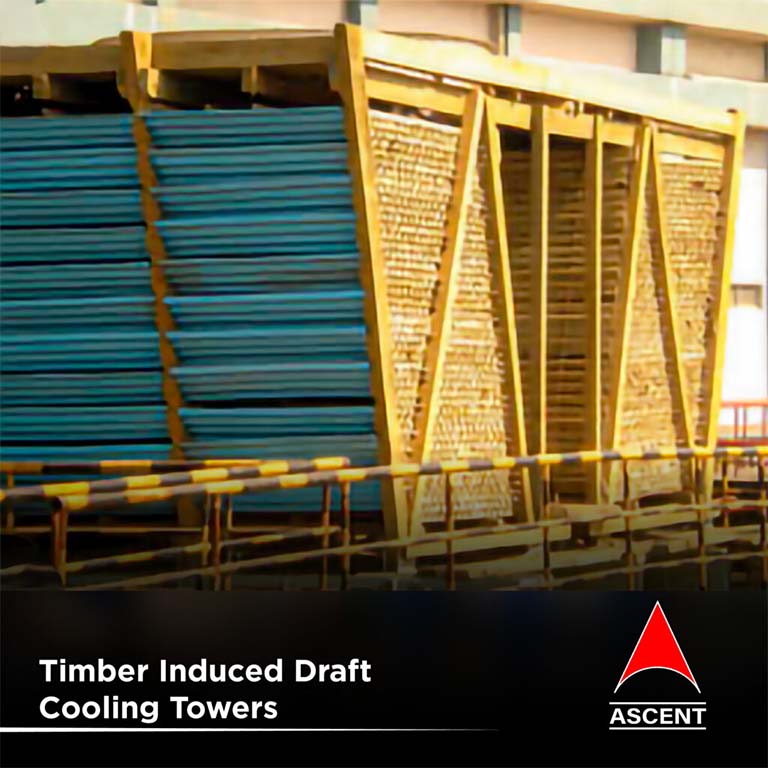
Home > Product Range > Industrial Cooling Tower > Cooling Tower by Types > Timber Induced Draft Cooling Towers
Timber Induced Draft Cooling Towers are advanced cooling systems designed to efficiently remove heat from industrial processes or HVAC systems. These towers utilize treated timber for structural components and feature induced draft technology to ensure consistent and efficient cooling. Known for their robust construction, cost-effectiveness, and eco-friendly design, Timber Induced Draft Cooling Towers are ideal for industries seeking sustainable and reliable cooling solutions.
Ascent Machineries & Engineering Services Ltd., headquartered in Goregaon, Mumbai, India, is a leading manufacturer, supplier, and exporter of Timber Induced Draft Cooling Towers. With a global presence across over 100 cities and countries, we deliver innovative cooling systems adhering to international quality and safety standards. Our commitment to excellence ensures tailored solutions for diverse industrial requirements.

Timber Induced Draft Cooling Towers are engineered for optimal performance and durability, combining the strength of treated timber with the efficiency of induced draft technology.
Timber Induced Draft Cooling Towers are competitively priced, offering significant savings through their durability, energy efficiency, and reduced maintenance requirements.
| Model | Capacity (million kcal/hr) | Price (₹) |
| Compact Model | 50 | 4,00,000 |
| Standard Model | 1,500 | 15,00,000 |
| Advanced Model | 5,000 | 55,00,000 |
Market Comparison:
Advanced fill media and induced draft design maximize heat exchange.
Treated timber resists warping, decay, and harsh environmental conditions.
Variable-speed fans reduce energy consumption.
Reduces water and energy usage.
Tailored designs to meet specific industrial needs.
Stainless steel hardware ensures longevity and minimal maintenance.
| Parameter | Details |
| Cooling Capacity | 50–5,000 TR |
| Water Flow Rate | Up to 20,000 m³/hr |
| Inlet Water Temp | Up to 65°C |
| Outlet Water Temp | As low as 30°C |
| Material | Treated Timber, PVC, Stainless Steel |
| Fan Type | Axial Flow |
| Noise Level | Below 85 dB |
| Country of Origin | India |
Ideal for installations with limited space.
Scalable designs for expanding industrial requirements.
Tailored to meet specific cooling needs.
Simplified installation with pre-configured components.
Cities: Mumbai, Delhi, Chennai, Bangalore, Dubai, Kuala Lumpur, and more.
Countries: India, UAE, Malaysia, South Africa, Kenya, UK, USA, Australia, and Vietnam.





These towers combine the structural strength of treated timber with advanced induced draft technology, ensuring optimal heat transfer and reduced energy consumption.
Yes, we offer tailored solutions to meet specific industrial needs, including size, capacity, and material.
Industries such as power plants, pharmaceuticals, food and beverage, and HVAC systems benefit significantly from these towers.
Delivery times typically range from 4 to 6 weeks, depending on specifications and location.
Yes, we offer comprehensive installation, training, and maintenance services to ensure seamless operations.
Upgrade to reliable and efficient cooling solutions with Timber Induced Draft Cooling Towers from Ascent Machineries & Engineering Services Ltd. Contact us today for tailored solutions and competitive pricing.
ASCENT MACHINERIES & ENGG. SERVICES Shop No. 2, 1st Floor, Nalanda Shopping Center, Station Road, Goregaon West, Mumbai - 400062, Maharashtra, India
+919819063898
sales@ascentmes.com
© 2025 Ascentmes.com. All rights reserved. Designed by Vebiotic Web Solutions Marketing by Adinads